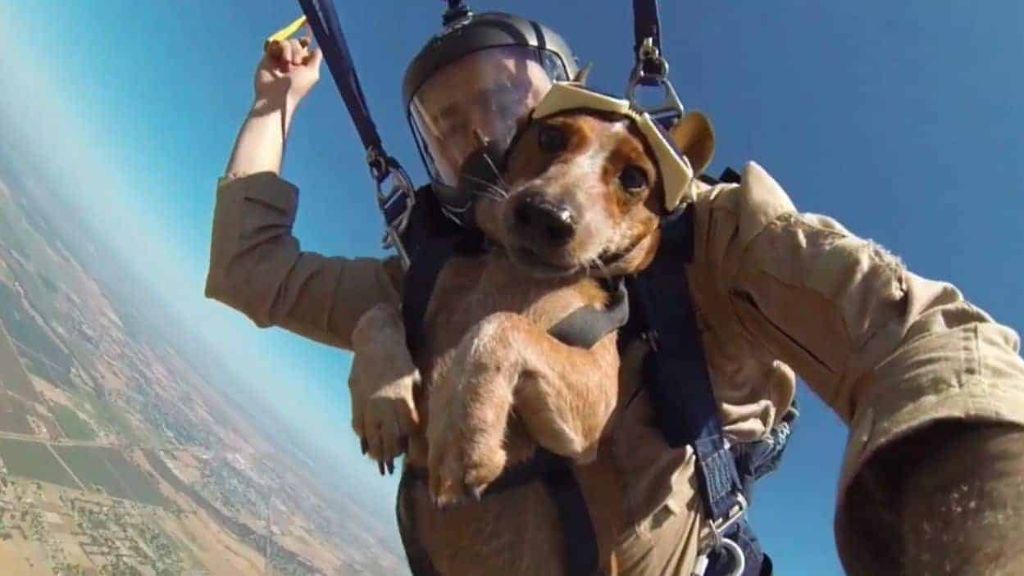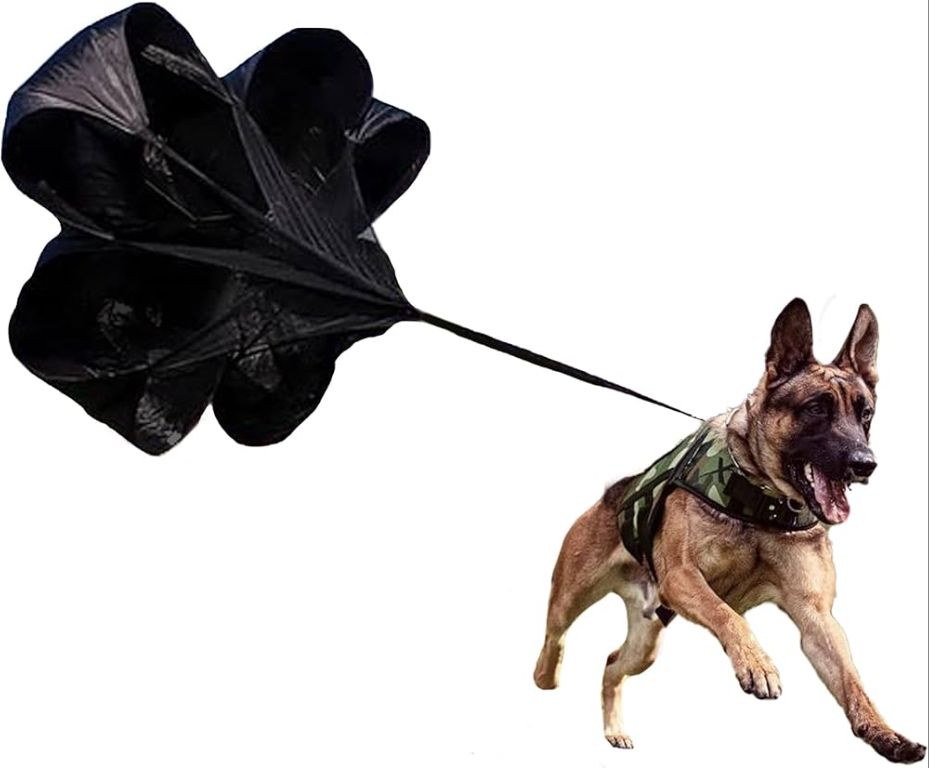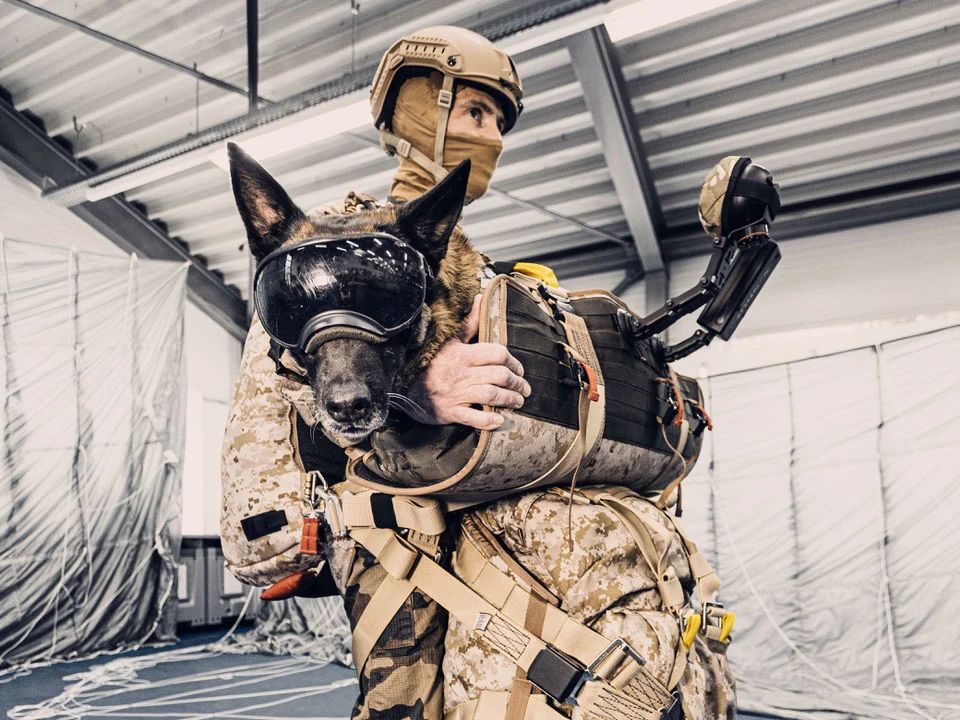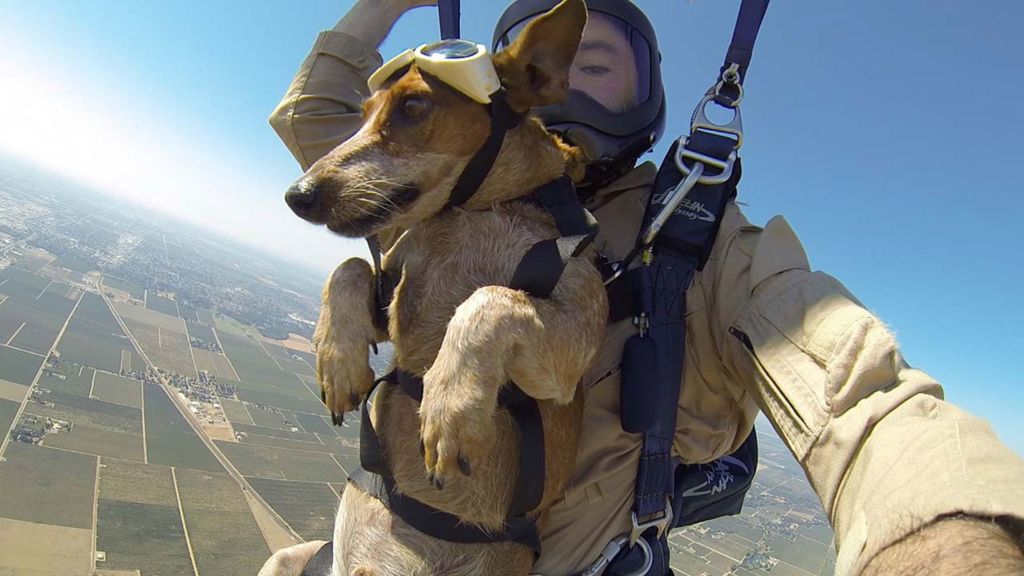Introduction
Dogs skydiving? It may sound like an extreme sport best suited to thrill-seeking humans, but some courageous canines have taken to the skies alongside their owners. Though rare, dogs have been trained and equipped to safely skydive out of planes, freefalling through the air before landing via parachute. This amazing feat requires intensive training and unique gear to make it possible for man’s best friend. The history of dog skydiving stretches back decades, as daring dog-and-owner duos have achieved record-setting jumps. Today, while regulated and controversial, dog skydiving still attracts devoted enthusiasts willing to put in the hard work of getting their furry companions airborne. This amazing niche sport will make you look at dogs in a whole new light.
History of Dogs Skydiving
The earliest known record of a dog skydiving was in the late 1990s and early 2000s when a Belgian Malinois named Eli was trained by skydiving instructor Shelia O’Grady. Eli completed over 30 tandem skydives with O’Grady, likely making him the first dog to skydive. Eli wore a custom harness attached to O’Grady’s chest when they jumped together (Fox6now, 2018).

In 1999, a Jack Russell Terrier named Buddy became likely the first dog to skydive solo when his owner Tim Hunt strapped a makeshift parachute to Buddy’s back and they jumped from a plane together over Perris, California. Buddy’s parachute opened successfully and he landed safely. This jump helped pave the way for other dogs to skydive solo (Guinness World Records, 2017).
Training a Dog to Skydive
Dogs require extensive training before they are able to skydive with their handlers. According to this source, dogs trained for military skydiving start their preparation as puppies. They are gradually exposed to the equipment, noises, and sensations of skydiving through reward-based conditioning. This allows the dogs to feel comfortable with the experience.

Key skills dogs need for skydiving include remaining calm during freefall, tolerating the pressure and wind, and being able to follow commands from their handler even at high speeds. Dogs are taught to tolerate the tight harness they wear and grow accustomed to the feeling of falling through repetitive low-altitude practice jumps. Their handler also works on training emergency procedures with the dog on the ground for safety.
Proper conditioning, desensitization, and rewards-based training starting from a young age are key to developing a dog’s confidence and ability to skydive successfully. With the right preparation, dogs can enjoy skydiving adventures with their trusted human partners.
Equipment Needed
Dogs require specialized equipment to safely and comfortably skydive. The most essential piece is the dog’s harness, which is specifically designed for skydiving. Harnesses distribute the opening shock of the parachute across the dog’s body and allow the handler to securely attach the parachute (Booth 2015). Popular options include the K9 Jump Harness and Air Dogs Canine Skydiving Harness, both designed with padded straps for comfort and multiple attachment points.

The harness size and fit is crucial – it must be snug enough not to shift during freefall but loose enough for the dog to breathe comfortably. Proper measurement and adjustments are done by a qualified skydiving instructor. ill-fitting harnesses can cause injury or allow dogs to slip out during descent.
In addition to the harness, dogs wear canine goggles to protect their eyes from debris, wind blast, and dryness. Ear plugs muffle the loud noises during freefall and landing as dogs have sensitive hearing. Optional paw protectors can also be used.
The final key piece of gear is the parachute system. A typical setup has one main parachute for the dog and handler and a reserve chute as a backup. Chutes are specially sized for the dog’s weight and attached to the harness (Hobika 2021). All gear must be meticulously maintained and routinely inspected for safety.
With the right harness fit, protective accessories, and parachute system, dogs can skydive in comfort and style.
Sources:
https://www.cpsworld.com/equipment/accessories/k9-jump-bag/
https://www.amazon.com/Parachute-Improve-Performance-Endurance-Strength/dp/B085J3F4X3
The Skydiving Process with a Dog
The step-by-step process for skydiving with a dog is as follows:

1. The owner and dog begin by getting fitted for proper skydiving gear. The dog wears a custom harness attached to the owner’s harness by a short tether. The dog also wearsdog goggles for eye protection.
2. The owner and dog board the plane together and fly up to the designated jump altitude, usually around 10,000-15,000 feet.
3. As the plane reaches jump altitude, the owner and dog move to the open door area of the plane.
4. When given the signal to jump, the owner holds the dog firmly as they leap out of the plane together.
5. After exiting the plane, the owner keeps a firm grip on the dog as they free fall together for 30-60 seconds, accelerating up to 120 mph.
6. At the designated altitude, usually around 4,000 feet, the owner deploys the parachute. The dog remains secured to the owner throughout the parachute deployment.
7. Under the open parachute, the owner and dog enjoy a peaceful 5-7 minute parachute ride down to the landing zone.
8. The owner prepares for landing by bending their knees and keeping the dog close. They execute a safe, controlled landing for both owner and dog.
9. Once on the ground, the dog is rewarded and praised for completing the exhilarating skydive!
For more on the step-by-step skydiving process with dogs, check out this informative article: https://www.skydivetecumseh.com/2021/10/19/can-dogs-skydive/
Notable Skydiving Dogs
Some of the most famous skydiving dogs include Whiskey the Weimaraner, Abby the Golden Retriever, and Gobi the Belgian Malinois. Whiskey holds the record for the most skydiving jumps by a dog with over 150 jumps (source). His owner started training him to skydive when Whiskey was just a puppy. Abby has also made over 150 jumps and is known for being the first dog to skydive into Soldier Field during a Chicago Bears football game (source).
One of the most recent canine skydiving stars is Gobi, a Belgian Malinois who serves in the Brazilian Air Force. She completed over 30 parachute jumps with her Air Force regiment in 2021. There’s even a photo of Gobi parachuting while wearing doggles to protect her eyes. All of these amazing dogs show that with the right training, there are no limits to what dogs can accomplish, even skydiving from planes!
Competitions and Records
There are a few competitions specifically for skydiving dogs to showcase their abilities and set records. In 2017, a German Shepherd named Arrow set a world record for the highest altitude dog skydive, jumping from 30,100 feet with his trainer according to Guinness World Records. Arrow reached speeds up to 205 mph during the freefall. This jump was part of Arrow’s training as a search and rescue dog.
Another dog named Kirby set records in 2015 for the most solo skydives by a dog in 24 hours with six jumps. Kirby also previously held the record for most solo skydives by a dog in a single day with three jumps according to Incredible Adventures. These competitions allow dogs to showcase their skydiving talents and push the limits of what’s possible.
Safety Concerns
Is skydiving safe for dogs? While dogs can certainly go skydiving, there are risks involved that require proper precautions to ensure their safety.
The main risks of skydiving for dogs include anxiety and stress, temperature regulation, the jolt of the parachute opening, and the impact of landing. Dogs have sensitive hearing, so the loud noises of planes and rushing air can startle them. Their paws can also get frostbitten at high altitudes. The sudden deceleration when the parachute opens puts stress on a dog’s body if the harness doesn’t properly distribute the force. And the landing impact must be minimized as dogs don’t understand how to bend their legs to absorb shock like humans.
To mitigate these risks, proper training and specialized equipment is essential. Dogs should be gradually introduced to the equipment, noises, and sensations of skydiving in a controlled environment. Custom dog skydiving harnesses distribute the force of the parachute opening and allow dogs to comfortably hang upright during the descent. Booties help protect their paws from cold temperatures. And flying dog-friendly skies and landing in soft grass is gentler for doggy landings. With training and the right gear, dogs can safely enjoy skydiving adventures. But pet owners should exercise caution and only work with experienced skydiving professionals to ensure their dog’s comfort and safety. For more on precautions and gear, see this informative guide.
Getting Started with Dog Skydiving
For dog owners interested in getting their dog started in skydiving, proper training and safety precautions are essential. Dogs’ excitement, athleticism, and eagerness to please their owners can make them well-suited for skydiving, but introducing it properly is key.
Experts recommend starting preparation early, gradually acclimating your dog to the equipment, sights, and sounds of skydiving. Get your dog comfortable wearing goggles and a jumpsuit-style harness. Expose them to the noise of planes and gusts of wind from a standing or moving position at ground level. Reward calm behavior and focus during these exercises.
Additionally, only skydive with breeds physically suited for the task. Breeds like Labrador Retrievers and Australian Shepherds that are energetic, intelligent and focused may adapt well. Consult your veterinarian to ensure your dog is in excellent health with no conditions exacerbated by altitude or strenuous activity.
When starting actual skydives, begin with short free falls and work up slowly in duration. Closely monitor your dog’s comfort level. Keep early jumps low stress by going tandem with a seasoned professional. Provide ample praise and treats upon landing to reinforce the positive experience.
With proper precautions, preparation and training, skydiving can be an incredibly exhilarating activity to enjoy with your dog. But be sure to progress slowly and keep your dog’s safety, comfort and enjoyment the top priority. Consult dog skydiving experts for guidance.
The Future of Dog Skydiving
Dog skydiving is likely to continue evolving and pushing new boundaries in the future. There will always be adventurous dog owners looking to share thrilling experiences with their canine companions. This means we may see new records set for highest skydives with a dog, largest groups of dogs jumping together, and more creative stunts performed during freefall.
One area where we are likely to see innovation is in the equipment and gear for dog skydiving. As technology improves, we may see specialized harnesses, goggles, and oxygen masks designed specifically for dog safety and comfort during skydiving. Lighter and stronger materials could allow dogs to move more freely while still being securely attached to their handler.
There is also room for growth in terms of training and certification for dog skydivers. Currently there are no universal standards for preparing a dog to skydive. However, we may see organizations emerge that provide structured programs to train dogs and certify them as ready for skydiving. This could ensure all dog skydivers meet certain safety criteria. It would also be great publicity for the dog’s achievements.
Competitions and records focused around dog skydiving are also likely to emerge. For example, we could see timed challenges to perform the most tricks during a set freefall period. Or contests to break records for largest dog skydiving formations. These sorts of events would help drive innovation and community around this growing extreme dog sport.
While the future is wide open, one thing is for certain – dogs will continue to take to the skies with adventurous owners and love every minute of it. The loyal four-legged daredevils are up for any challenge alongside their favorite humans. With improved training and equipment, we are likely to see dog skydiving become safer and more accessible in the coming years. The sky is the limit for this intrepid canine sport.